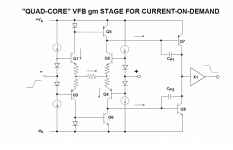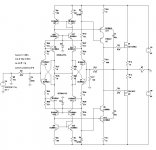A triple mirror CFA.... use your own OPS and devices and see how it does.
THx-RNMarsh
View attachment 408321
Do you have a slightly larger version of this pdf ?
People of my age will have a hard time reading this ... ;-)
Well stated Pavel. It is true that VFB 'can' be very slow due to lack of local feedback in the input stage, and current drive limits of a simple differential pair, but the circuit that you just put up and a complementary differential Jfet input design do not have those limitations.
My concern with CFA topologies is not the design of the input stage, as much as the ADDED COMPLEXITY of the second and output stages that seems to go along with most designs put up here. In my world, less is best in serial, and more is OK in parallel.
My concern with CFA topologies is not the design of the input stage, as much as the ADDED COMPLEXITY of the second and output stages that seems to go along with most designs put up here. In my world, less is best in serial, and more is OK in parallel.
"In my world, less is best in serial, and more is OK in parallel."
Me also !
I still not understand why a lot of CFA designers presents THD to be a good parameter or the ppm battle ...
Me also !
I still not understand why a lot of CFA designers presents THD to be a good parameter or the ppm battle ...
Last edited:
One may get current on demand with VFB as well.
That was shown already in this thread, but it became so big that so many good things are buried under.
I still not understand why a lot of CFA designers presents THD to be a good parameter or the ppm battle ...
THD is only one parameter. If we can lowered THD without sacrifice another parameter why not?
I want to build an amp with highest slew rate as possible, lowest THD as possible but keep it simple as possible. Even if I can not tell the different sound of 200V/uS and 350V/uS amp, I will build 350V/uS 😎😀
That was shown already in this thread, but it became so big that so many good things are buried under.
Yes, and ---- It is good to note that it can be done no matter how. But, again... this is the CFA thread. So naturally we are focused only on CFA. Until some excellent CFA got designed, we had no idea what CFA was capable of. A lot of myths have been dispelled. Pro and cons observed. Solutions to them. Now we can build and compare how they sound as worthy competitor.
THx-RNMarsh
Last edited:
THD is only one parameter. If we can lowered THD without sacrifice another parameter why not?
I want to build an amp with highest slew rate as possible, lowest THD as possible but keep it simple as possible. Even if I can not tell the different sound of 200V/uS and 350V/uS amp, I will build 350V/uS 😎😀
YES! And, it has been shown here that it can be done with CFA, also.
So, someone, some where, some time will do an amp just to show off numbers only.... lowest THD/IM, highest SR, lowest S/N, highest power output, DC to Light. I would like to listen to that attempt one day. Its just like cars... how high performance can you get and then race them against other competitors. Who will be the one to set that bar?
I use cars because a lot of people can identify with that excess and the design challenges. I dont need to go faster than the speed limit but going from zero to 60mph/100k-hr in 3 seconds in first gear is an experience anyone can enjoy. If they choose to. Or enjoy what it takes to develop a specialized auto that can produce 1000 HP per cylinder (V8) and go from zero to 100mph in .75 seconds -- on fuel. What does it take in chassis development to handle such power. A lot is learned by pushing the limits and over-coming obstacles. Competition between VFA and CFA has been good, too.
Dreaming? Maybe.
But, THx for the dream. Great effort for the love of music and curiosity and challenge.
-Richard Marsh
Last edited:
Do you have a slightly larger version of this pdf ?
People of my age will have a hard time reading this ... ;-)
Does your PDF have a zoom feature? That should work. Hopefully, you can see the topology.
[limited file size here might not allow large enough files]
View attachment 3x mirror cfa.pdf
THx-RNMarsh
Well stated Pavel. It is true that VFB 'can' be very slow due to lack of local feedback in the input stage, and current drive limits of a simple differential pair, but the circuit that you just put up and a complementary differential Jfet input design do not have those limitations.
My concern with CFA topologies is not the design of the input stage, as much as the ADDED COMPLEXITY of the second and output stages that seems to go along with most designs put up here. In my world, less is best in serial, and more is OK in parallel.
John perhaps you havent been paying so much attention in the thread, many of the CFA designs presented are actually of less complexity than VFA designs. Also the less complex CFA designs outperform VFA designs.
One may get current on demand with VFB as well.
This is the best of both worlds. If anyone is interested in this combo circuit, see John Curl. He put up an advanced circuitry he uses. See JC for his topology he put up here at DIYAudio... cant find it now. I doubt, for audio, anyone has a more refined circuit. But, now we have SIM to play with it to see what the topology produces.
THx-RNMarsh
Last edited:
I am i line with JC- As few serial components as possible (needed) and then do the housekeeping right, much is gained by supplying the best working conditions for our amplifier components. Current sources are better than resistors for current set, mirrors are better than rail-resistors and so on.. most of the distortion mechanisms are really because currents and voltage are not really separated, and thus our devices operate in a mixed environment generating their own error signal.
Compressive-expansive: You can also look at these two IPS from a distortion spectrum perspective. Compare Odd/even harmonic distribution.
THx-RNMarsh
THx-RNMarsh
Last edited:
One may get current on demand with VFB as well.
Hmm.
This is classified as VFA, but I think it's a CFB in disguise and that's why you get current on demand behavior.
The - input is buffered and therefore both inputs are hi z - I think this is why they called it a VFA.
But, the peak current into the TIS is set by the bridge resistor and not a current source as in a VFA and, it's constant GBW which in my book are both defining characteristics of a CFA.
However, since someone somewhere has elected to call it a VFA, and a long debate here will not lead anywhere, I propose we leave it as is.
post 5422 -- "hybrid"
Absolutely CFA-current on demand
Has the high gain of a typical VFA and the "margin extension" ... like
a CFA.
This is where I had a problem , TOO much gain. I had the full 80db CLG
out to 100K and a UG of 10 Mhz !
Got it to work , just lower the gain. But then it becomes like a typical
VFA with lackluster Slew.
I think JC uses Jfets as IP to make this stable - all high Hfe BJT's ....
It becomes a "screamin' oscillator".
Did not try to run it at higher currents ... this might be the key , as
that center "bridge" resistor is still dependent on some sort of current
source .... no direct output source to "tap into" .
.
OS
Absolutely CFA-current on demand
Has the high gain of a typical VFA and the "margin extension" ... like
a CFA.
This is where I had a problem , TOO much gain. I had the full 80db CLG
out to 100K and a UG of 10 Mhz !
Got it to work , just lower the gain. But then it becomes like a typical
VFA with lackluster Slew.
I think JC uses Jfets as IP to make this stable - all high Hfe BJT's ....
It becomes a "screamin' oscillator".
Did not try to run it at higher currents ... this might be the key , as
that center "bridge" resistor is still dependent on some sort of current
source .... no direct output source to "tap into"
 .
.OS
Conceptually, derived by adding a separate follower (low Z) driving the input. See Line #4534.
[Seems then like a CFA to boost input current 'on-demand'.]
THx-RNMarsh
OK I' m outta here for awhile. Off to the airport in a few hours.
[Seems then like a CFA to boost input current 'on-demand'.]
THx-RNMarsh
OK I' m outta here for awhile. Off to the airport in a few hours.
Last edited:
it's constant GBW which in my book are both defining characteristics of a CFA.
No, constant GBW is a property of VFA. It's easy to make a CFA with the same BW at 0 as 20dB so in that case GBW is 10X at 20dB gain. The amp shown will have 10X less BW at 20dB gain.
PMA is right H-bridge input amps have always been considered VFA's
Last edited:
No, constant GBW is a property of VFA. It's easy to make a CFA with the same BW at 0 as 20dB so in that case GBW is 10X at 20dB gain.???
PMA is right H-bridge input amps have always been considered VFA's
Sorry, you are correct. I seem to have written the opposite of what I meant.
On your second point, I think it's been called a VFA I believe because both the + and the - inputs are high z inputs.
I simmed it - the gain/ frequency behavior is similar to a CFA and the peak current into the TIS is not limited by a current source as in a VFA. In my book this makes it a CFA.
- Home
- Amplifiers
- Solid State
- CFA Topology Audio Amplifiers

